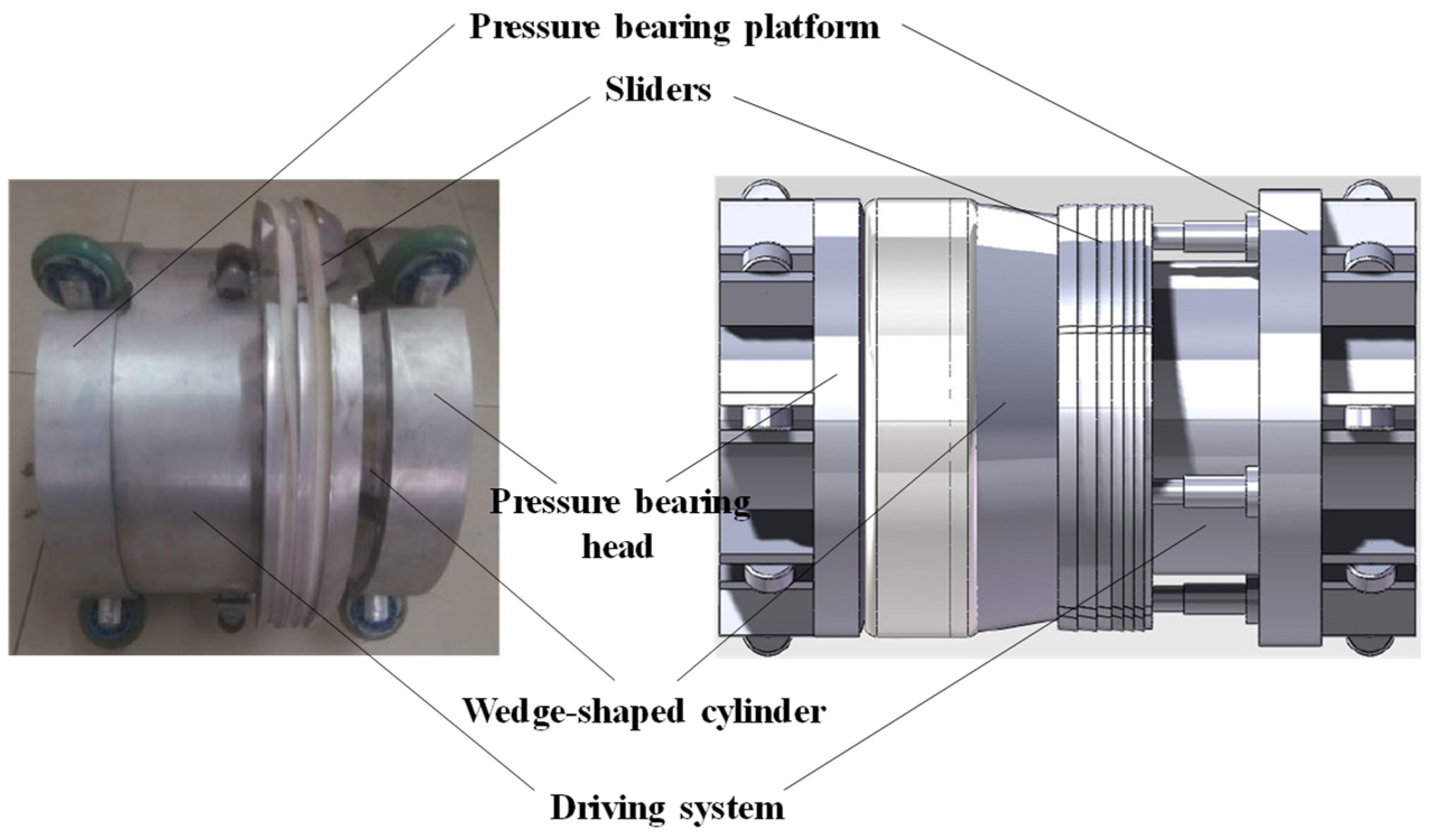2.3. Numerical Simulation Results of Pipeline Plugging Process
During the plugging process, the motion of the in-pipe medium belongs to the problems of high Reynolds number. Assuming that the fluid in the pipeline is incompressible and no heat transfer occurs, the mass conservation equation and momentum conservation equation of the PIPR can be expressed as follows:
Therefore, the simple algorithm was chosen for calculation. At the same time, due to the high Reynolds number in the flow field, large vorticity vibration is generated during the plugging process, so the model is set as the standard
k-
ε model, whose turbulent kinetic energy (
k) equation (shown in Equation (3)) and turbulent dissipation rate (
ε) equation (shown in Equation (4)) can be expressed as follows:
Among them, , , , , , .
Pipeline inner wall has a great influence on the turbulence model, while the standard k-ε model is mainly suitable for the calculation of turbulent flow field, where there may be a large velocity gradient, turbulent kinetic energy transfer, energy consumption, etc. Therefore, the near-wall method is selected, and enhanced wall processing is applied to improve the calculation accuracy.
Because the PIPR is operated under the action of in-pipe pressure difference, its motion law conforms to Newton’s second law.
Among them, v is the motion speed of PIPR, P1 is the upstream pressure of PIPR, P2 is the downstream pressure of PIPR, Ad is the equivalent cross-sectional area of PIPR, Fg is the component of the self-weight of the PIPR in the velocity direction, Ff is the friction force between the PIPR and the pipeline inner wall.
The component of the self-weight of the PIPR in the velocity direction is:
Among them, m is the mass of PIPR, g is the gravity acceleration, γ is the angle between the pipeline and the horizontal line.
The friction force
Ff is caused by the interaction between the cup and the pipeline inner wall, which is an elastic deformation force. The friction force
Ff of the PIPR is obtained according to the matching relationship between the cup and pipeline inner wall.
Among them, is the radius of PIPR, is the contact length between the PIPR and pipeline wall, is the friction coefficient between the PIPR and pipeline wall, is the pressure of the contact surface, is the elastic modulus of the cupola material, is the change value of the cupola in the direction of the radius, and is the Poisson ratio of the cupola material.
By substituting Equations (6) and (7) into Equation (5), the force model of the PIPR during the plugging process can be expressed as:
Without considering the energy input outside the PIPR, the axial motion model of the PIPR can be expressed as follows:
The radial motion model of the PIPR is as follows:
Among them, p is the density of the PIPR, vz is the axial velocity of the PIPR, vr is the radial velocity of the PIPR, fpz is the axial component of the volume force of the PIPR, fpr is the radial component of the volume force of the PIPR, r is the radial stress of the PIPR, is the circumferential stress of the PIPR, and rz is the shear stress of the PIPR.
The numerical simulation of the traditional PIPR with the footstep-shaped end face is performed. In order to observe the simulation results of the in-pipe obstructed flow field more intuitively, the center surface of the pipeline is taken as the observation surface.
Figure 5a shows the fluid pressure on the center surface of the pipeline before the plugging operation. It can be seen that the pressure downstream of the flow field shows a clear regional distribution and a decreasing trend along the flow direction. This pressure distribution is mainly caused by the external structure of the PIPR.
Figure 5b shows the distribution of fluid pressure on the center surface of the pipeline when the plugging process reaches 99%. It can be seen that a significant pressure difference has occurred between the upstream and downstream. The continuous accumulation of high-pressure fluid in the upstream leads to an increase in in-pipe pressure, which can cause large shock vibrations on the PIPR.
The velocity distribution of the flow field around the PIPR is shown in
Figure 6. Through the plugging operation, the velocity values of in-pipe fluid particles vary significantly. As shown in
Figure 6a, before the plugging process starts, there is a local area on the front-end face of the PIPR with a flow velocity close to zero, called the stagnation zone. The blockage of the PIPR can lead to the dissipation of fluid kinetic energy. At the same time, the fluid also causes a certain impact on the PIPR. Boundary layer separation and vortex have occurred at the edge of the PIPR’s tail, which can form a clear reflux zone with a certain fluctuation in the flow direction. Due to severe energy loss in the reflux zone, the flow velocity significantly decreases. The flow velocity distribution after the plugging process is shown in
Figure 6b. The fluid inside the entire pipeline is almost stagnant, indicating that the upstream and downstream of the PIPR are isolated. At this time, the plugging operation is completed.
Figure 7 shows the velocity distribution of fluid particles on the central surface of the pipeline. It is clearly shown that the highest velocity of in-pipe fluid particles exists in the gap between the PIPR and pipeline wall. Comparing
Figure 7a,b shows that with the increase in plugging progress, the velocity of fluid particles in the gap becomes higher. The velocity value after the plugging process is much higher than that before the plugging process. As the plugging operation progresses, the pressure difference before and after the PIPR continues to increase, and the fluid passing through the slit also gains more kinetic energy.
The force acting on the PIPR is particularly important for the structural design and control of the PIPR, which directly determines the movement status of the PIPR. Therefore, the relationship between the force of the PIPR, plugging process, and pipeline operating parameters is analyzed, as shown in
Figure 8.
Figure 8a shows the relationship between the force of the PIPR and the plugging process and inlet pressure. From the initial state to the plugging state of 80%, the in-pipe upstream pressure increases, which can increase the force on the PIPR continuously. Until the plugging process reaches 80%, the force of PIPR begins to decrease due to the in-pipe pressure distribution. The pressure difference between the upstream and downstream is relatively large, and negative pressure may occur in some areas. Therefore, the pressure generated on the PIPR can be partially offset.
Figure 8b shows the relationship between inlet velocity and the plugging process, as well as the force of the PIPR. It can be seen that the plugging process and inlet velocity have a significant impact on the force fluctuation of the PIPR. The smaller the inlet velocity, the smaller the impact force on the PIPR. When the plugging process reaches 50%, the flow velocity directly affects the in-pipe pressure distribution.
In summary, all three variables involved have a significant influence on the force of the PIPR, and the effects of the plugging process and inlet velocity are more pronounced. The PIPR with the original stepped end face bears a high level of stress during the later stage of the plugging process. In addition, significant pressure fluctuations and vortex-induced vibration occur, mainly caused by the increased turbulent flow field excitation, and the plugging operation is not stable. Therefore, the PIPR’s end face with a certain degree of radian is proposed to reduce the disturbance and pressure gradient of the in-pipe flow field.





































